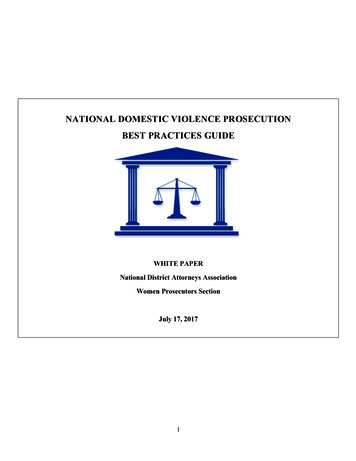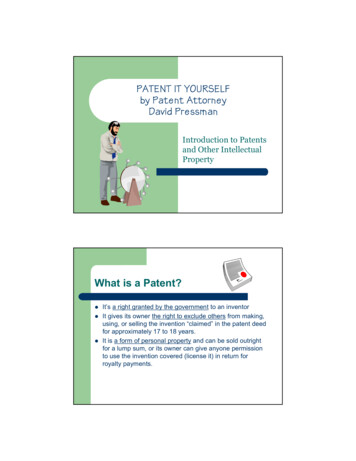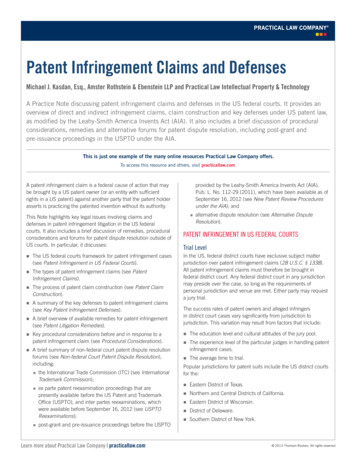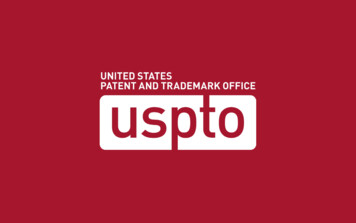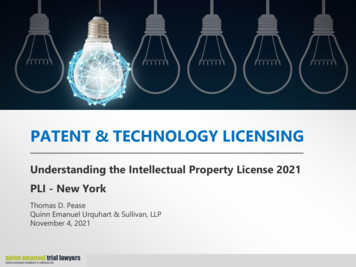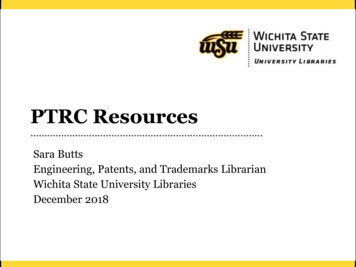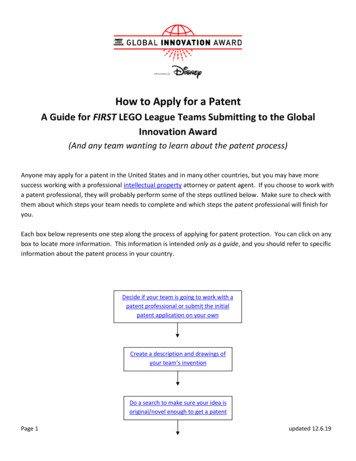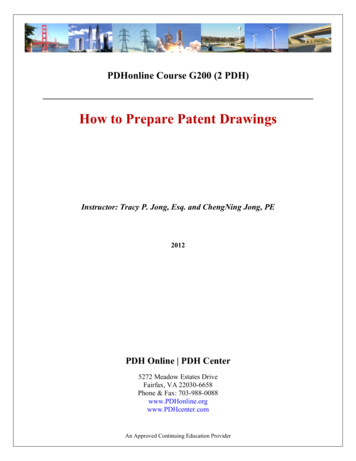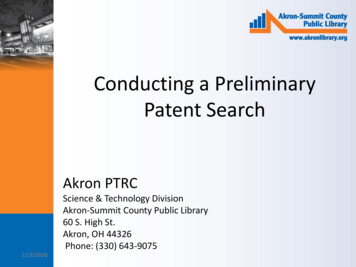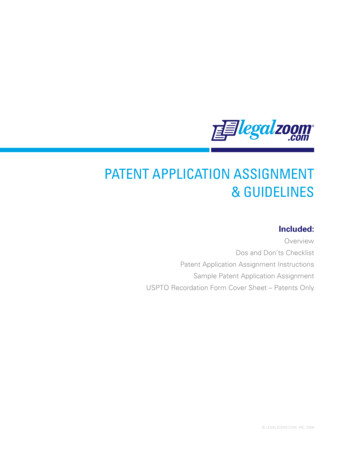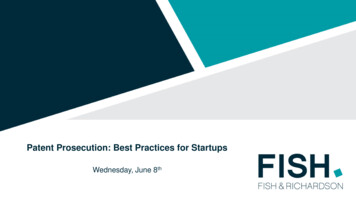
Transcription
Patent Prosecution: Best Practices for StartupsWednesday, June 8th
Meet The SpeakersJonathan SolomonPrincipalAnnie KingPrincipalfr.com 2
Overview Housekeeping– CLE– Questions– Materials http://www.fr.com/webinarsfr.com 3
Agenda Topics What is a patent, and how is it different from other IP?Why get a patent?What is in a patent?What is required for a patent application to be issued as a patent?What does the patent office do with a patent application?Startup patent mistakes, and how to avoid to them.fr.com 4
What is a patent, and how is it different from other IP?Why get a patent?
What is Intellectual Property? Intellectual Property (IP) refers to creations of the mind:inventions; literary and artistic works; and symbols, names, images, and designs used incommerce. Patents – protect inventions and provides a temporary monopoly in exchange for publicdisclosure. Copyrights – protect written or recorded expressive content. Trademarks – protect words, symbols, logos, designs, and slogans that identify &distinguish products or services. Provides protection for brands, and lets people know thesource of goods. Trade Secrets – protect confidential business information. Once public, no protection.fr.com 6
What is a Patent? A grant from the government of the right to prevent others from: making, using, offering tosell, selling, or importing the invention(s) claimed in the patent. Personal property – can be bought, sold, licensed, bequeathed, mortgaged, assigned. Limited Term – 20 years for utility and plant patents; 14 years for design patents. Territorial – must obtain patent in every country where protection is desired.– Choose your own coverage – which technology, which markets, and your cost sensitivity. United States Patent and Trademark Office (USPTO) – tasked with examining US patentapplications and granting US patents.fr.com 7
Why Get a Patent? To build your business:– To gain entry to a market.– Positive PR for a new/young company.– To increase attractiveness for investment/sale. “Patent pending” alone has significant weight. Many acquisitions may be primarily based on IP. To use against others:– To exclude competitors from market.– To use as bargaining chips to exchange with other companies for use of their intellectual property.– To generate revenue by way of royalty payments. To protect yourself down the line:– Telling your invention story when you are sued for patent infringement.– Defensive filing – patent publications can serve as a defense by creating prior art for competitors.fr.com 8
Start-up Mistake (SUM) #1: Knowing what your patentdoes and doesn’t do Patents provide a “negative” right to keep others from doing what you’ve claimed Does not give you the right to practice your own invention! Consider a freedom to operate (FTO) before you design commercial products, andcontinually monitor after going to market Example:– Even though you hold patents on the screen and display drivers used in a cell phone, othercompanies may hold patents that cover the processor, memory, and applications.fr.com 9
SUM #2: Not Being Strategic Early Develop an overall IP strategy– Patents are powerful, but can be narrow Consider your entire set of technology, and where/how you need to protect your productor solution– Understand the market, your competitors’ products, and where the technology is going– Strengthen through diversification of IP, where possible Start-ups needs to:– Understand their reason for obtaining patents– Understand which of your solutions / ideas can be patented, and have a plan on how to identifythose with your teams and counsel Consider which IP is best for your specific solution– Patents?– Trade secret trademark?– Copyright?fr.com 10
What is in a patent?
Types of Patent Applications Provisional Utility (Non-provisional) Patent Cooperation Treaty (PCT) application Design Application – protects the ornamental features of an object; not nearly as commonas utility applications. Plant Application – protects distinct and new varieties of plants that are asexuallyreproduced.fr.com 12
Provisional Application Never examined, never will issue as a patent.Automatically expires in 12 months.Think “place holder” for priority date.Provides 12 months to further refine the invention (BUT added matter only gets the newdate!).– File incremental provisional applications to protect development during 12 month period Must be “re-filed” as a Utility or PCT application within 12 months of filing date to maintainpriority date. Claims of later filed Utility must be fully supported by provisional application to be entitled tofiling date of the provisional application.fr.com 13
SUM #3: Misusing Provisionals Start-ups commonly file “provisional” or informal patent applications as a way to saveon legal fees While provisionals can “save the date”, they’re only beneficial for what is includedand described in sufficient detail in the application New Railhead Mfg. Co. v. Vermeer Mfg. Co., 298 F.3d 1290 (Fed. Cir. 2002)– Provisional application did not support a later claimed drill bit angle for drilling rock formations– Thus, the patent was not entitled to filing date of the provisional application– Patent was invalid because of an on-sale statutory bar Provisionals are a great option when used correctly. Coversheet or very informal provisionals without thought or reason can cause issues.fr.com 14
Utility Application Application that is examined by the USPTO and may ultimately be granted as a patent. Protects the functional or structural (not ornamental) aspects of an invention. This is the text that may ultimately be granted as a patent (after possible amendmentsto the claims). After filing, no substantive changes can be made without risking a “new matter”rejection. During pendency of a “parent” utility application, one can file “continuingapplications” such as a:– Divisional - same specification as parent but different invention– Continuation - same specification and general invention as parent– Continuation-in-Part - specification has added matterfr.com 15
PCT Application International “place holder” for filing date.PCT must be filed within one year of priority application.Does not issue as a patent.Applicant must eventually proceed with actual filings in countries of interest(“national phase” filings) (153 PCT contracting states). The granting of patents remains under the control of the national or regional patentOffices. Convenient way to keep options open globally before deciding in which countries topursue applications.fr.com 16
Why File a PCT Application Advantages of the PCT route:– Defers expenses while preserving priority date for up to 30 months.– Allows time to assess marketability and patentability before making significant patent filinginvestments abroad.– An International Search Report and International Preliminary Report on Patentability are provided. Optional response/arguments/amendments can be made by Applicant Disadvantages of the PCT:– Additional cost of filing the PCT application.– Delays start of prosecution, so may delay issuance of patents.fr.com 17
Anatomy of a Utility Application Specification––––Written description of the inventionHow to make and useAbstract (short summary)Can contain figures (important for devices) Claims– Purpose of the specification is to support the claims(e.g., teach how to make and use).fr.com 18
Anatomy of a Utility Application Title of InventionCross-Reference to Related ApplicationsStatement Regarding Federally Sponsored Research or Development (if applicable)Reference to Sequence Listing, a Table, or a Computer Program Listing Compact DiscAppendix (if applicable)Background of the InventionBrief Summary of the InventionBrief Description of the Drawings (if any)Detailed Description of the Invention (including Examples)ClaimsAbstractDrawings (if any)fr.com 19
Patent Claims Most important part of the application– The patent claims define the subject matter protected– Thus, to secure broadest rights, claims must avoid unnecessary limitations Must define an invention that is novel and non-obvious.Define what patentee can prevent others from making, using or selling.Whole purpose of the application: support the claims.Must be clear enough for skilled practitioners to determine whether a process/productwould infringe. Claim language is unusual – written in “legalese”.– Run-on sentence.– Weird punctuation.– Your English teacher would hate it.fr.com 20
Anatomy of a Patent ClaimIndependent and dependent Claims.Claims 1 and 2 are independent claims.Claim 3 is a dependent claim.Example 1:1. A chair comprising a seating surface, four legs, and a back.– Preamble - “A chair”– Transitional Phrase - “comprising” / “consisting of”– Body - “a seating surface, four legs, and a back”2. A chair consisting of a seating surface, four legs, and a back.3. The chair of claim 1, wherein the back is made of wood.Example 2:1. A compound of formula X.fr.com 21
Classes of Claims Apparatus - Directed to what the invention is (product) not what it does System - Directed to a combination of multiple devices Method - Directed to a way of doing something Composition of matter - Directed to products where the chemical nature of the substanceor materials used, rather than the shape or form of a product, is the distinguishingcharacteristic Product-by-process - a product, but recite the steps of the process that create the productfr.com 22
What is required for a patent application to be issued as apatent?
What are the Requirements for Patentability?Must comply with the: Statutory Subject Matter Requirement—35 USC § 101 Utility Requirement—35 USC § 101 Novelty Requirement—35 USC § 102 Non-Obviousness Requirement—35 USC § 103 Written Description Requirement—35 USC § 112(a)Enablement Requirement—35 USC § 112(a)Best Mode Requirement—35 USC § 112(a)Definiteness Requirement—35 USC § 112(b)fr.com 24
The Statutory Subject Matter Requirement Requires that the invention fall into a category that Congress has designed the patentlaws to protect. US law specifies four categories of patent-eligible subject matter:––––process (or method)machinemanufacturecomposition of matterfr.com 25
Statutory Subject Matter Court interpretations of the statute have defined the limits of patentable subject matterand there have been major changes/tightening over the few years. Judicially created exceptions to those four categories:––––Product of NatureLaws of NatureNatural PhenomenaAbstract Ideas A claim that falls within one these exceptions is not valid. Different results and impact in different fields and technologies.fr.com 26
The Utility Requirement Requires that the invention be “useful.” Use must be specific, substantial, and credible. Low bar– Juicy Whip, Inc. v. Orange Bang, Inc.fr.com 27
The Novelty Requirement Requires that the invention not be in the public domain prior to the filing of the patentapplication:––––Patenting of the inventionPublication of the inventionPublic use of the inventionSale or offer for sale of the invention File priority application before any public disclosure, or use, or sale, or offer for sale(“bar dates”).fr.com 28
The Novelty Requirement Public Disclosure and Grace Period An inventor’s public disclosures will not preclude a patent in the US, if the patentapplication is filed within one year of the disclosure.– AKA the “grace period”– An inventor’s public article and speeches are not prior art if made within one year of patentapplication. But rights may be lost abroad! Best practice is to file a patent application before any public disclosure occurs!!!fr.com 29
The Novelty Requirement Typical bar date triggers:––––––Journal articlesProduct release brochuresConference presentations, abstractsDisclosures not protected by non-disclosure agreement (NDA)Website postingsSelling/Offering for sale (even under a secrecy agreement)fr.com 30
SUM #4: Hiring IP Counsel Too Late Waiting to involve IP Counsel can be detrimental to your IP rights – any and all of them IP Counsel can:– Prevent problems that could sink a new company– Reduce the cost and complexity of problems that do arise For patents:– Up to a 1 year grace period after the first public disclosure to file for a US patent – But many other jurisdictions have no, or very limited, grace periods– US law awards patents on a first inventor-to-file system, not a first to invent system Patent rights only apply in the jurisdictions in which you apply and receive a grant– Example: The Rubik’s Cube A single patent in Hungary – applied in 1975 and granted in 1977 No patent protection anywhere else Protected in US by trademark and copyright law, but without a patent, no protectionagainst copying the functional aspects of the devicefr.com 31
The Non-obviousness Requirement Even if novel, invention is not patentable if it differs from the prior art only by way ofan “obvious” modification. “Obvious” means obvious to a person of ordinary skill in the art at the time theinvention was made.– POSITA is a strange concept – they are assumed to have read and known everything everavailable at the time of the priority date of the claims. Keeps inventor from claiming something that is not inventive over somethingbelonging to the public or someone else. Highly subjective.fr.com 32
The Written Description Requirement Requires the specification to describe the invention in such a way as to prove theinventor was in possession of the full scope of the invention. Keeps inventor from overreaching and claiming at a later time more than he/sheactually had in-hand at time of filing. Can be more difficult to satisfy for inventions in unpredictable fields (e.g., pharma,biotechnology).fr.com 33
The Enablement Requirement Requires the specification to teach one of skill in the art how to make and use theinvention without undue experimentation. Inventor should describe how to practice the invention – no “hiding the ball.” Frequently an issue for the “unpredictable arts” (biology and chemistry), especiallyfor unproven methods of treatment.fr.com 34
The Best Mode Requirement Must describe the best way of performing the invention. Public entitled to the best way you know of at the time of filing – quid pro quo. AIA implications– “failure to disclose the best mode shall not be a basis on which any claim of a patent may becancelled or held invalid or otherwise unenforceable”fr.com 35
The Definiteness Requirement Requires a patent’s claims to inform those skilled in the art about the scope of theinvention with reasonable certainty. Defines the metes and bounds of the invention such that a person reading the claimswould reasonably know what is being protected.fr.com 36
What does the patent office do with a patent application?
General US Prosecution Outline File Application Possible Formality Issues – Notice to File Missing Parts and Possible RestrictionRequirement First Examiner’s Office Action– No reason for alarm! Applicant’s Reply to First Office Action– Amendments and/or arguments Final Examiner’s Office Action Applicant’s Reply to Final Office Action– Appeal Conclusion of Prosecution (allowance or abandonment)– Request to Continue Examination – reopening after a Final Office Action Examiner interviews throughout the processfr.com 38
Prosecution of US Application (1) File application and complete any formalities, including filing an InformationDisclosure Statement disclosing all pertinent prior art of which the applicant is aware. (2) Examiner may insist on splitting multiple inventions into separate applications(divisional applications) before examining each (“Restriction Requirement”). Restriction Requirements – One invention per application– If two or more inventions are claimed in a single application, applicant will be required to elect oneinvention for examination.– The other inventions may be pursued in a divisional application – aka a “child” application.fr.com 39
Prosecution of US Application (3) First office action rejects the claims on various grounds–––––PTO will perform a prior art search.The applicant is notified in writing of the examiner’s decision.Sets forth reasons for adverse action, objection, or requirement.Claims may be rejected.It is common that some or all of the claims are rejected on the first office action by the examiner;relatively few applications are allowed as filed (AKA a “first action allowance”). Either the examiner or the applicant can request a telephone or in-person interview todiscuss and resolve the issues.fr.com 40
Prosecution of US Application (4) Applicant responds to each ground of rejection with arguments, factual evidence,and/or amendments to the claims and/or specification, as appropriate. (5) If examiner was not fully satisfied by Applicant’s response, she will send a secondoffice action, most likely final, explaining what issues remain.fr.com 41
Prosecution of US Application (6) Various options after final action, including appeal. (7) Eventually prosecution concludes with either an allowance of all claims still in thecase, or abandonment. (8) After allowance, applicant pays the issue fee and the patent issues. Duty of disclosure: submit information disclosure statement (e.g., patent publications, journalarticles, etc.) to the patent office On average it takes 2-3 years to obtain an issued U.S. patent in from the date the utility applicationis filed. Varies depending on the art unit and the examiner the application is assigned to at theUSPTO. US Utility Patents have a 20 year term, calculated from earliest claimed non-provisional (i.e., U.S.Utility or PCT application) priority date.fr.com 42
Additional Start-Up Mistakes andConsiderations
SUM #5: Relying on bad, or short-term, advice Start-ups have limited resources, and must spend frugally, but intelligently Avoid:– Filing for filing’s sake In some limited cases, more may be better, but definitely not in every case– Going with the cheapest provider without getting the quality you need Cheaper to start with a worse product leaves you without the flexibility and strength youneed to see the application turn into a strong patent Once initially filed, essentially stuck with your first application Looks for IP counsel willing to become a strategic partner– You don’t want a scribe, you want someone to question, expand, and solidify your technical andlegal position– Find counsel willing to learn and understand your needsfr.com 44
SUM #6: Realistic Budgeting Understanding costs at the beginning of work, and the amount of work needed A good patent application and prosecution costs money, but it doesn’t have to bemoney from out of the blue Considerations:––––––Costs are spread over years, but there are initial costsInitial searching to potential save costs and focus workPreparing and filing the applicationOngoing prosecutionForeign costs – significant additional fees, but worthwhilePCT application can save or delay initial fees, but later national filings will require addition costsand foreign associate fees Ask early, and discuss budgetsfr.com 45
SUM #7: Thinking Vs. Knowing What You Own Start-up companies can sometimes (incorrectly) assume that they will own the IPcreated by:––––EmployeesVendorsContractorsJoint Venture Partners Government research funds may come with important strings attached Written agreements should be in place before work begins– Employee handbooks– Contractor agreements– Etc.fr.com 46
SUM #8: Not Solidifying Inventorship at the Start Claim-based determination of inventorship Incorrect inventorship can create unenforceable patents– You cannot add vanity non-inventors– You can’t leave someone off you don’t like or don’t want to get credit (without strategic claiming, at least) If you don’t include someone who should be an inventor, you may find an issue years later– Each inventor is an owner of the entire patent, allowing each owner (without a prior assignment to yourcompany) to make, use, offer to sell, and sell the patented invention without regard to the wishes of any otherco-owner.– Worst case, a co-inventor who hasn’t assigned can assign their rights to your competitors and destroy yourinfringement case. Another reason to get IP counsel involved early, and defining inventors as part of the initialdisclosure discussions and application preparationfr.com 47
SUM #9: Not Being Aware of Competitors’ Patents Start-ups are not blind to the fact that competitors will have patents, but sometimescan be unaware of the implications A competitor’s patent may prevent a Start-up from making or selling a product,regardless of whether the Start-up also had its own patents on their solution– Think 3M’s jingle – “We didn’t make the X, we made X better.”– The corollary they’ve also now made it so the inventor of X can’t include that improvement withouta license. As products incorporate technology from many different patents, unauthorizedinfringement of any patent may be a show-stopperfr.com 48
SUM #9: Not Being Aware of Competitors’ Patents Even the simplest product could be covered by numerous patents&DeviceCombinationMethod of ManufactureWidgetMethod of UseChemical Composition A computer processor is covered by more than 1500 patentsfr.com 49
Thank You!Jonathan SolomonPrincipalSolomon@fr.comAnnie KingPrincipalaking@fr.comPlease send your NY/NJ CLE forms to mcleteam@fr.comAny questions about the webinar, contact Michelle Zazzero at zazzero@fr.comA replay of the webinar will be available for viewing at http://www.fr.com/webinars Copyright 2022 Fish & Richardson P.C. The opinions expressed are those of the authors and do not necessarily reflect the views of Fish &Richardson P.C., any other of its lawyers, its clients, or any of its or their respective affiliates. This presentation is for general informationpurposes and is not intended to be and should not be taken as legal advice and does not establish an attorney-client relationship.These materials may be considered advertising for legal services under the laws and rules of professional conduct of the jurisdictions in which we practice.Legal advice of any nature should be sought from legal counsel. Unsolicited e-mails and information sent to Fish & Richardson P.C. will not be consideredconfidential and do not create an attorney-client relationship with Fish & Richardson P.C. or any of our attorneys. Furthermore, these communications andmaterials may be disclosed to others and may not receive a response. If you are not already a client of Fish & Richardson P.C., do not include anyconfidential information in this message. For more information about Fish & Richardson P.C. and our practices, please visit www.fr.com.
(8) After allowance, applicant pays the issue fee and the patent issues. Duty of disclosure: submit information disclosure statement (e.g., patent publications, journal articles, etc.) to the patent office On average it takes 2-3 years to obtain an issued U.S. patent in from the date the utility application is filed.
